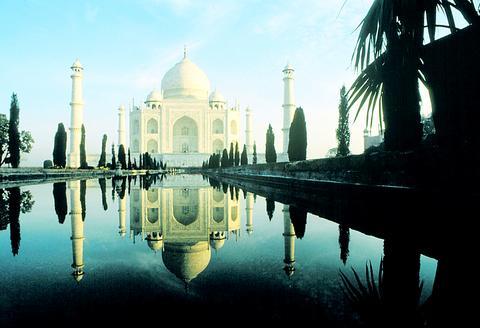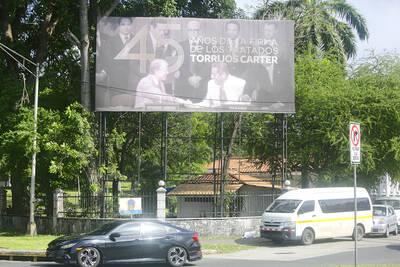The Taj Mahal, with all its wonder and majesty, is not the only spot in Agra resplendent in elegance. Heirs of craftsmen carry on traditions in jewelry, brassware and inlaid marble, but a showroom displaying the unique embroideries of the late Shams Uddin offers a spellbinding presentation of the works by the innovative artist.
Awarded the "Padma Shri" on Jan. 26, 1989 by the government of India, a distinction comparable to a knighthood, Shams is hailed as the originator of embroidery in three dimensions.

PHOTO: DPA
His creations over more than three decades reflect such startling realism and brilliant colors the subjects, primarily wildlife, appear ready to amble out of their frames.
"I didn't know there was anything else to see in Agra except the Taj Mahal," said American tourist Janet Grove. "This type of artistry astounds me."
There is no admission charge. "Everyone is welcome," said Ghanshyam Mathur, noting explanations are available in English, German, French, Spanish, Italian and Indian dialects.
Entering a large room plunged into darkness, light suddenly focuses on a huge hanging embroidery of a bouquet of flowers seemingly hanging into the room from a vase embedded with semi-precious stones.
Measuring 2.13m by 1.52m, the work took the artist 4,170 days to complete, said Mathur, who guides visitors through the collection. None of the embroideries displayed, supplied by his family, are for sale. Shams, who died in 1999 at the age of 86, "was a naturalist," Mathur said.
Maximizing the dramatic effect is the light focused only on a single piece at a time. The gold and silver incorporated in one embroidery amount to 27,000 carats. Among the 23 wildlife scenes in silk threads is a large-scale embroidery of fighting cocks in dazzling hues that occupied Shams for 1,475 days, a stalking Indian tiger requiring 620 days and 21 other wildlife scenes, all made by hand.
A cheetah hunting partridges and a lioness bringing down an African zebra portray with stark vividness the realities of life in the wild.
In contrast, there are also works conveying the serenity of African elephants enjoying an evening drink, peacocks playing, parakeets alighting on a branch and Arabian stallions running through the plains.
Shams made "free hand sketches of his subjects," explained Mathur. Working alone, he embroidered them in cotton threads over and over until he obtained the required thickness and movements. Then, he took fiber from silk threads and twisted them together in the shades required.
"In the process, he created original unparallel works of art," Mathur said.
A long list of dignitaries have praised Shams' masterpieces. The first president of India, the late Rajendra Prasad, and the first prime minister, the late Pandit Jawahar Lai Nehru visited his exhibition in 1960. Shams embroidered the official seal of the president of the US and presented it to Lyndon Johnson in 1966. It is currently in the deceased president's library.
A portrait of late president Abraham Lincoln was turned over to former president Gerald Ford in 1976 and placed in the National Archives. Britain's Prince Charles was another recipient of a Shams' creation on visiting Agra in 1980. He was also honored with a special award by the late Prime Minister of India Indira Gandi.
A Hindu, Shams also respected figures from other religions, evident in his portrayal of Jesus surrounded by sheep in a pastoral setting embroidery called the Good Shepherd. The large embroidery required 6,570 days and is comparable in size to the figure of Lincoln. Viewers awed by the tapestries, each in its special glass case, are also amazed at the abundance of gemstones numbering in the thousands, including rubies, amethysts, garnets, topaz and an array of others.
Many of the stones were donated to Shams by the Kohinoor Jewellers adjacent to the showroom, Mathur said.
The single edifice captured on the embroideries on show is the Taj Mahal. The elaborate tribute to the wife of Emperor Shan Jahan after she died in childbearth in 1631 is depicted by Shams in white as it is seen in the brilliance of midday.
Equisite symmetry and harmony are the keynotes of the tapestry, as they are of the world-renowned mausoleum.
Although nearly blind in his later years, Shams continued his work, relying on family members to help him recreate in three dimensions his beloved subjects.
The technique is carried on now by his sons and other relatives, working out of their homes.

April 14 to April 20 In March 1947, Sising Katadrepan urged the government to drop the “high mountain people” (高山族) designation for Indigenous Taiwanese and refer to them as “Taiwan people” (台灣族). He considered the term derogatory, arguing that it made them sound like animals. The Taiwan Provincial Government agreed to stop using the term, stating that Indigenous Taiwanese suffered all sorts of discrimination and oppression under the Japanese and were forced to live in the mountains as outsiders to society. Now, under the new regime, they would be seen as equals, thus they should be henceforth

Last week, the the National Immigration Agency (NIA) told the legislature that more than 10,000 naturalized Taiwanese citizens from the People’s Republic of China (PRC) risked having their citizenship revoked if they failed to provide proof that they had renounced their Chinese household registration within the next three months. Renunciation is required under the Act Governing Relations Between the People of the Taiwan Area and the Mainland Area (臺灣地區與大陸地區人民關係條例), as amended in 2004, though it was only a legal requirement after 2000. Prior to that, it had been only an administrative requirement since the Nationality Act (國籍法) was established in

Three big changes have transformed the landscape of Taiwan’s local patronage factions: Increasing Democratic Progressive Party (DPP) involvement, rising new factions and the Chinese Nationalist Party’s (KMT) significantly weakened control. GREEN FACTIONS It is said that “south of the Zhuoshui River (濁水溪), there is no blue-green divide,” meaning that from Yunlin County south there is no difference between KMT and DPP politicians. This is not always true, but there is more than a grain of truth to it. Traditionally, DPP factions are viewed as national entities, with their primary function to secure plum positions in the party and government. This is not unusual

US President Donald Trump’s bid to take back control of the Panama Canal has put his counterpart Jose Raul Mulino in a difficult position and revived fears in the Central American country that US military bases will return. After Trump vowed to reclaim the interoceanic waterway from Chinese influence, US Defense Secretary Pete Hegseth signed an agreement with the Mulino administration last week for the US to deploy troops in areas adjacent to the canal. For more than two decades, after handing over control of the strategically vital waterway to Panama in 1999 and dismantling the bases that protected it, Washington has